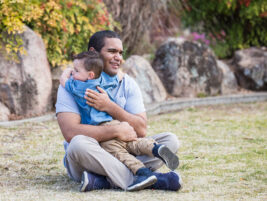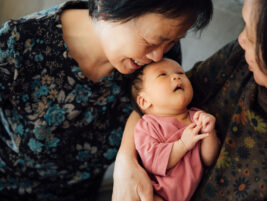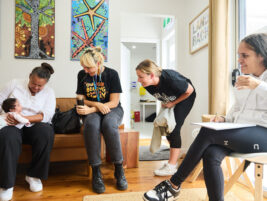Introduction
War broke out on Israel’s northern border in the summer of 2006. Within a few hours, the entire population of northern Israel numbering tens of thousands was being bombed by Katyusha rockets. This unexpected war came as a total shock to the population of the north, causing panic to both Jews and Arabs, as they were quite unprepared for it, both physically and emotionally. Within a short time, the danger to citizens’ lives became more and more apparent; the bombings increased and became more widespread.
The breakout of war at the height of the summer found the children of the north in the middle of their summer vacation, thus rendering parents unable to be assisted by facilities usually provided by schools, and every family had to quickly come up with its own solution for the sudden state of emergency. Meanwhile, damage to property and lives increased, and this included injury to children. Some families were forced to leave their homes and make their way to the center of the country, with a sense of uncertainty about the future. Others who did not have that option, were obliged to stay at home, but there were also families who chose to remain in the bombarded areas together with their children. This caused families and children to cope with extremely difficult situations, sometimes very dangerous ones.
Sahar, the mother of three children between the ages of four and nine, lives with her family in an Arab village which was also under constant attack. She describes what happened: “I went out to work every morning, I had no choice. My older son, aged 9, took care of his brother. I locked them in the house so that they wouldn’t wander around outdoors. Because our village doesn’t have an air raid warning system, I phoned home every time I heard the siren in the town where I worked, and told the children to go into the protected room”.
Simcha, a Jewish mother of two children aged 3 and 6, who works in the hospital, was bound by an Emergency Order requiring her to report each morning for work, like many others. The hospital had set up a babysitting facility for the children of employees, and Simcha arrived at work every morning after a twenty-minute drive under threat of Katyusha explosions. She was in her sixth month of pregnancy at the time. She says: “One morning, as I was driving with the children, I heard the air raid siren. I stopped the car at once, quickly took the children out of the car, and the three of us lay face down on the road next to the car, as per the instructions given by the media. I don’t think the children really understood the danger we were in. I tried to make it into a game, even though I was almost paralyzed with fear. Of course it took me a long time to calm down”.
The war lasted about a month. As it went on, many families were forced to move from one place to another, to find themselves a new place of refuge, and many even decided to return home after an exhausting and confusing period spent wandering from place to place. This is what happened to the family of Gili, a mother of three living in a kibbutz in the north of Israel. “We left the kibbutz in a hurry the day after the war began, prepared to stay away from home for a few days. We went to stay with friends who live about half an hour away. The following morning, after a sleepless night during which the bombs were exploding there too, it was clear that we had to go further away. We went down to the south of Israel, and every few days, we went somewhere else. We were homeless. After two weeks of this, I was fed up and decided to go back home to the kibbutz. The kibbutz looked like a huge army camp, and the noise was unbearable: the blasts from the rockets coming from Lebanon, and the artillery fire from our army. But in spite of the chaos we had a routine. We were in our own home and that was the main thing, but when I think of it with hindsight, it was like a nightmare! I was in a constant state of anxiety about the children’s safety. I was afraid something would happen to them and I knew that if it did, I would never forgive myself. But at the same time, at least we were at home, and a home is a home, it’s a secure place”.
When the war ended, life in the north returned to normal. The general population, and the parent population as part of it, was forced to function again as if nothing had happened. This meant an abrupt and instant transition, without any period of gradual adjustment, from the role of mothering during an emergency back to coping with a normal routine.
Group background:
The idea of planning a project involving mothers and infants after the war, emerged from two types of professional impressions:
1. Clinical meetings with parents made us realize that parental coping was very challenging and complex both during and after the war. However, within the maternal population, mothers of infants and small children constituted a unique group whose complex experiences should be considered separately. The complexity derives from a dual relationship existing on the part of the adult world with infancy. On the one hand, the fact that the baby or the small child is at a pre-verbal developmental stage, lacking the ability to communicate freely, makes it difficult to understand his inner world, and makes it hard for the mother to identify the source of his distress.
On the other hand, a widely accepted concept maintains that infants are in such a preliminary stage of development that they lack the ability to absorb and understand the events of external reality. This approach is based on the idealization of the world of infants, according to which the baby functions according to its basic needs, and if these are provided, changes in the external reality will have minimal effect on the infant Time and again, we come across statements that infants “do not understand”, and if so, they do not feel or experience. We, as mental health professionals caring for babies are surprised to find that this line of thinking as expressed not only by laymen, but is also popular amongst professionals working in various therapeutic areas.
In his writings, Winnicott (1965) relates to the mother as the best expert in understanding her baby, and emphasizes the importance of empowering the maternal role in the development of the child, in comparison to the role of professionals. Indeed, many mothers, with their natural healthy intuition, clearly sense the baby’s active ability to participate in the real world.
Clinical experience indicates that difficult life experiences are liable to weaken the natural intuitive ability of the parent to “read” his or her baby, and thus create a misattunement between the two. If reality becomes difficult and causes acute stress, mothers find it harder to identify their babies’ need and will be less available for them.
2. Meetings with community professionals ( pediatricians, nurses at community clinics, nurses in baby clinics, managers of daycare centers, social workers) in the immediate period following the war, emphasized a few additional facts:
- Mothers express more stress in their daily routine.
- A great increase in referral of babies to pediatricians about symptoms worrying the mothers
- Community professionals expressed lack of expertise in dealing with stressful events involving parents.
Clinical work in the first post-war months showed that many parents felt dissatisfied with the way they coped as parents during the war. As a result, they felt insecure about their ability to cope in similar situations in the future.
These understandings led us to plan a project for mothers of infants and young children to empower their maternal capabilities and expand their coping repertoire when faced with situations involving tension and stress. The aim was prevention, rather than treatment. At the sixth world congress of the WAIMH in Finland in 1996, Peter Fonagy spoke of prevention as the main target of infant psychotherapy. He appealed to society in general and to therapists and researchers in mental health, to invest in the welfare of babies. Clearly and concisely, he maintained that caring for the mental health of babies is the key to preventing emotional disorders throughout life. These words gave us the impetus to develop our own insights and to reach out to this specific group of mothers who experienced the war but did not suffer direct traumatic events and who were not diagnosed as post-traumatic.
Each group was composed of 5-7 mother-baby dyads and two therapists. The presence of the baby/infant was a precondition for participation in the group. Each group consisted of 10-12 sessions. After 6 sessions each dyad was videotaped separately for 10-15 minutes. Mother and therapists watched the video together and discussed it.
The groups were held in Kiryat Shmonah and in Tzfat, two towns that were heavily bombarded during the war. Kiryat Shmona has a long history of years of constant bombardment and a great number of the mothers in the groups were born and brought up in war-like life.
Group procedure proceeded along two central lines
1) Group discussion
Expressing feelings, tensions and fears, sharing personal conflicts with the group, was the first goal. It brought about an immediate relief of guilt feelings, of shame, and feelings of anger with themselves and their children. Group discussion facilitated the mentalization process (Fonagy 1991) and enabled the mother to think of the infant as a separate entity, person with intentions and thoughts of its own.
In this process, special emphasis was placed on maintaining a balance between discussing mothers’ stresses and babies’ needs. Many times, this procedure brought about an immediate change in mother-baby interaction followed by a growing sense of mutual enjoyment
S., an orthodox-religious young woman, shares with the group great emotional difficulties she encountered during her pregnancy. She met her husband through a matchmaker and was married soon afterwards. The pregnancy that immediately followed, was actually a period of building the relationship. The couple had a hard time adapting simultaneously to the pregnancy and to each other. “I was constantly thinking about intimacy, pregnancy and divorce, all at the same time”.
Z., who comes from a completely different background, immediately joins in, and tells the group of the great tension between her and her spouse during her pregnancy. This tension heightened her anxiety and made her fearful of the life awaiting her, “bringing up a child on her own”. This dialogue between these two very different women, created a very special intimacy that affected the rest. Lying between the mothers, the two babies found a common interest in the same toy. The therapists make note of this parallel joint experience between the two mothers and the two babies. The group watches quietly. The mothers are watching contentedly, smiling.
2) Observing and watching the infants
The ability to watch a baby seemed to be a main component in strengthening the emotional resilience of mothers of babies. The maternal role requires the ability to observe the other as a separate entity. Jessica Benjamin ( 2005 ) discusses the importance of mutual recognition in the development of a mother-baby relationship. In this developing relationship between these two partners, there is also a third partner, not necessarily an additional person or anything tangible, but rather an organizing principle that allows the relationship to become recognized and mutual. The existence of a third person creates an intersubjective symbolic space. As the infant grows, the mother is the one who must represent the wish for that third, for the idea that organizes the relationship. Thus, the mother keeps simultaneously the desire for her own subjectivity, her awareness of her child’s needs, and the empathetic knowledge of her child’s experience.
We felt that observation can become a facilitating tool both for the acquisition of mutual recognition and the process of mentalization.
In groups composed of dyads, there are expanded possibilities for observation:
Mother observes her infant
Mother observes other infants
Mother observes other mother-infant dyads.
In our groups, we chose to add another aspect of observation. Halfway through the sessions, every mother-baby dyad was video-taped for 10-15 minutes in free play, after which mother and therapists watched the videotape together. This allowed for another aspect of observation:
Mother observes herself and her baby
In her work, Susan McDonnough uses this technique of filming the family and joint observation with the therapist as part of therapeutic intervention. She notes that by means of such observation of the interaction, the parents become more aware both of the positive interactive behaviors that we, as therapists, want to encourage, improve and expand, and the interactions that are less enjoyable or suitable that need to be redirected, changed or disposed of. Observation by means of videos also allows parents to take notice of what they say to the child and how they say it.
Aims of the groups:
Preventive work with mothers
- To facilitate and improve mothers’ ability to observe their children
- To identify behavioral characteristics that are indicative of existing stress in adults and children
- to identify coping patterns in anxiety states
- To learn how to acquire self-relaxation and self-regulation in anxiety states
In presenting the work with our groups, we chose to focus on a number of issues:
- The significance of the infants’ presence in the sessions
- The importance of observation in developing emotional resilience
- Daily pressures vis-à-vis the pressures of wartime
- The role of the therapists
1. Significance of the infant’s presence in the sessions
The actual presence of the baby in therapy with mothers has been used to develop a new line of therapeutic thought. Today different approaches of dyadic parent-infant therapy are becoming more and more familiar ( Watillon 1993; Lieberman & Pawl, 1993).
At first, most mothers questioned our request for babies to be present, but soon realized the great advantage of it.
The significance of the baby’s presence could be divided into two parts:
The advantage for the dyad:
The baby’s presence gives a special quality to the issues raised in the room, and is a central component in the emotional processes mothers go through in the group. Very frequently, anxiety expressed by the mother brought about an immediate special reaction of the infant. These were powerful situations, usually causing great excitement and making the maternal insight more acute. Every time this happened, the mothers were astonished by the amazing sensitive ability displayed by these non-verbal babies.
T. shares with the group a dilemma she had about the choice of day care for her daughter. She tells the group how hard this decision is for her since it could mean a lot for her daughter. She has to make a choice between the voice of professionals recommending that she should be transferred to a group of older children and her inner voice that advises her to keep her daughter in a small, protected, warmer day care. As she tells her story she begins to show stressful reactions, her voice starts to shake, her body becomes tense and she looks nervous. She expresses an extreme sense of “there’s no way out” and finds it difficult to be attentive to the comforting that other mothers are trying to give.
All of a sudden, the little girl crawls over to her mother, climbs into her arms, and becomes irritable and agitated, causing the mother to stop talking and to direct her full attention to her . Mother takes out a bottle and begins to feed the baby. The therapists note that the baby was drawn into the mother’s distress. The mother, however, seemed to be comforted from her own distress by taking care of her daughter. The dyad detaches from the group and become more involved with one another. The therapists describe the story to the group and reflect the stress that is created by situations in which the mother has to make a choice. They turn to the mother and talk about the pain that arose, and reflect the parallel process formed between the mother’s distress and that of the baby.
They emphasize the important place the mother has in containing and consoling, whatever choice she makes. At the following session, T. shares with the group that she has decided to listen to her inner voice. She sounds proud of herself. It seemed that bringing up her dilemma with the group and making the connection between her distress and that of her baby, gave her an insight that facilitated her decision. In addition, the process gave her a sense of empowerment and increased her confidence in her ability to make decisions as a responsible mother.
In another group, S. expresses her disappointment that her seven month-old baby son does not show any particular preference for her, and relates to other female family members, her mother and her sister, the same way. She describes how she yearns to “be special” for her baby, and how painful this situation is for her. The group starts asking her questions, S. is quiet, finds it hard to talk. A minute later, she starts crying. The baby climbs into her lap and clings to her. The mother is overtaken by emotion, and the therapist addresses the non-verbal “speech” by which the baby expressed his special relationship with his mother.
The advantage for the group:
The baby’s presence was important for two reasons
- Observation of the babies as a group, with the guidance of the therapists, created a wide space for the individuals in the group. The mothers could move within the group between being involved and active to a more distant role of watching and observing
- The intensifying formative process in the group of the mothers brought about a parallel process within the group of babies. Many a time one could see an inner circle of babies within an outer circle of mothers. The experience of gaining strength by being a part of a group, made it clear for the mothers that their babies were actually experiencing a similar experience. They realized that the babies, too, were a group in their own right. As a result, they found it easier to move about individual watching their own baby or other babies, and at the same time, observing them as a separate group.
In one of the sessions, the subject of discussion was maternal competence. H, who was born in Kiryat Shmonah, and often raises the subject of her childhood in the shadow of Katyusha explosions, became very agitated about the topic of competence. She raises many doubts about how she functions as a mother, and asks the group to strengthen her as a “mother who knows”. The group tries to understand why she finds this issue so distressing. The mother begins to talk about her traumatic first experience as a mother – A birth to a premature baby, lengthy hospitalization and the anxiety from which she suffered regarding the baby’s survival. She describes herself as an “over-protective” mother, associating this with the traumatic birth. She gathers up her baby into her arms while talking, and suddenly becomes restless and has breathing difficulties. The therapist goes over to her, holds her physically, and guides her how to breathe and relax. The group watches quietly. What they see is “a mother holding a mother holding a baby”. H. calms down helped by the support and reinforcement she receives from the group. The therapists address the group and reflect upon what H. and the group went through. They ask H. to say what she feels. “I know I can. I am a good mother”. The group echoes her words. The atmosphere is very calm. Meanwhile, the group of infants in the inner circle are undergoing a similar process. The calm exuded by the mothers has an immediate impact on the babies.
This process shows how the group of mothers undergoes a reinforcing experience that develops into calmness and self-empowerment. This experience is instantly transmitted to the babies, separately to each baby, and together as a group that is self-contained and forming a single voice.
The mothers identified this parallel process, and the group is unanimous regarding the shared insight about their babies’ sensitive ability to understand and internalize emotional states on a complex level.
2. The importance of observation
Observation, was found to be of great significancein facilitating group process. During the course of the sessions, mothers underwent an important in their ability to watch and observe. However, from the beginning on, we saw striking differences between mothers in their ability to be an observer. Mothers under high levels of pressure, were limited and rigid in their ability to adjust to the role of an observer. They showed this inability in all the various observations (observing her baby, other babies, dyads, and videotapes of her own dyad).
Our last group meeting, was a group of single mothers all referred to us by the social welfare department. Social workers described these women as coping with difficult life situations. In this group, the atmosphere was highly-strung and often the topics brought up were surprisingly extreme.
L. arrives with her 15 month-old daughter. She describes her difficult separation from her spouse after a period of extreme violence during her pregnancy. She tells her story in a very restraint and distant manner. As L. is telling her story, her daughter is wandering around the room. She does not play with the toys and is constantly on the move. All of a sudden, she approaches a baby playing peacefully on the mat, and pulls his hair. This aggressive behavior repeats itself again and again. The mother’s reaction is very minimal, saying “no, don’t”, but doing nothing else. A few minutes later, the toddler tries climbing up on the mats piled in the corner of the room. Again, we witness the lack of an appropriate response by the mother. The mother seemed incapable of relating and reacting although she was clearly watching her daughter. The therapists had to intervene directly to ensure the safety of her daughter and that of the other children.
In this group, we found that the mothers had a much lower ability for observation and watching. The ongoing experience of stress seemed to create a state where the mothers had a diminished ability to observe their children. Prof. Claude Shem Tov (2005) from New York relates to this phenomenon in therapeutic intervention with young children and their parents after 9/11. He maintains that mothers who have undergone a threatening traumatic experience, be it single or ongoing, behave in a survival mode that causes a decrease in responsiveness level. These mothers are not really available for their babies.
This group of high pressured mothers enabled us to experience together with them the amazing ability to change. Surprisingly enough, we saw a significant change after watching a video of themselves with their baby. A joint observation of them interacting with their child, enabled insights, that were an expression of their yearning to be “good mothers”. Watching the video with a mother figure who is attentive and watchful of positive maternal behaviors, created a gentle ambience that allowed the mothers to let go to some extent of the survival mode, and expand their ability to observe.
L. is the mother of Y. a 2 year old toddler. Y. moves around always holding a bottle in his mouth, biting it with his teeth, hands free to play. In the video watched by the mother and the therapists, Y. can be seen walking around the room, looking around, exploring. Suddenly he approaches his mother and lays down on her lap. He puts his hand down under his mother’s dress, reaches her breast, and starts playing with her nipple. L. explains that Y. Is constantly doing this; she does not remember since when, but does not consider it anything unusual. The therapist inquires about the period of infancy and nursing. L. suddenly becomes agitated, raising her voice: “I don’t know, I never thought about it but maybe it has to do with the way he stopped nursing”. She tells a horrifying story, how her spouse, after their separation, broke into her home while she was nursing, and kidnapped her 8 month old baby straight from her breast. L. did not see her baby for the following 3 months until the police found his hiding place and returned the baby home . “There was no weaning. He was literally torn from my breast. Could this be the reason he always wants a nipple in his mouth, and holds on to my nipple so that it won’t be taken away from him?”. This was a very inspiring and moving insight for L. She never had the chance to think of this event until she became the observer of the scene.
The stories related by L. and by the other participants showed us that mothers can be helped to improve their own observation ability and become more attentive to their children’s distress.
3. Daily pressures vis-à-vis the pressures of wartime
Will coping with daily stress situations prepare mothers to cope with wartime?
In our first groups, maternal coping with the war took a more central place, but despite this, mothers showed a marked preference to bring up topics from their daily routine. In almost all the following groups, bringing up issues having to do with war-time was less welcomed. Mothers were more eager to use the group experience as a source of support for every-day stresses and tensions. There are a number of reasons for this:
– The time that had passed since the war.
– Many of the mothers had been pregnant during the war, which meant that at time of war, they were dealing with a fantasmatic baby, not a real one.
– The presence of the baby in the room was a constant reminder to present coping and the need to find solutions to existing dilemmas
– Most mothers in our groups were mothers of firstborn. Many women see this as a cause of constant stress, lacking a sense of confidence, and concerned about their ability to fulfill this role. They need support in their present life which is often experienced as dramatic and intense in itself.
Our conclusion is that coping with stressful daily situations efficiently, could strengthen emotional resilience amongst mothers of infants. Focusing exclusively on stressful war-related situations was perceived as being too threatening. In order to preserve the stability of the maternal role, mothers tend to make a split between routine time and wartime, and do not see the connection between the coping processes in the two types of situations. Our impression was that over-focusing on wartime situations would be less efficient than focusing on the routine situations. Indeed, it enabled the mothers to internalize and exercise efficiently individual coping styles so that it will be available in intense stressful situations.
The situations involving daily tensions that were raised during group discussions included coping with illness, of mother or child, traumatic birth, home accidents, car accident, father’s unemployment, parent going abroad, etc. The therapists helped each participant identify her personal emotional resources and coping options. For example, Y. learns that what she is comfortable with is letting herself have a dialogue with herself in stressful situations before doing something. This enables her to organize her thoughts and thus, regulate the behavior of her baby in a better manner. E. tells how touch and movement relaxes her. The therapists indicate how often she uses this style when taking care of her baby too, and they reinforce her ability to find a joint organizing and regulating pattern for herself and her daughter.
One of the sessions begins with R. saying: “I have no resources of my own to cope with stress situations, I always need someone else’s help. She finds the courage to share something very painful for the first time. She tells the group of fears she has at night, linking this to her childhood when she was exposed to shelling for years on end. She recalls a scene from her early childhood, a night of air raid sirens and Katyushas, her father carrying her down to the bomb shelter. The group expresses empathy, asks questions, giving her a sense of understanding and caring. R. is concerned that as a result of her personal history, she has become an over-anxious mother. The group calms her fears, and they relate to nighttime as a symbol of loneliness, saying that being afraid at night indicates fear of being alone. The therapists repeat her opening sentence and suggest that she reframe it thus: “The emotional resource I use for coping with stress situations is to be helped by someone else”. They encourage her to relate to this as her strength, her special style, rather than relating to it as a weakness.
4. The role of the therapists
A central aspect of the group process is the relationship between the group and the therapists. In an article about the ambivalence of mothers towards babies and infants, Leon Hoffman (2003) describes the unique processes that develop in groups of mothers and babies. He maintains that positive transference to the therapist and to the setting takes place as a result of the regular weekly meetings in which a sort of family atmosphere is created. He mentions that positive transference is reminiscent of Stern’s concept of “the good grandmother transference” when the young mother, as a result of the motherhood constellation, searches for a maternal image who appreciates, supports, helps, teaches and admires her.
Hoffman emphasizes that since these groups are not therapeutic, the therapist must bear in mind that transference is not supposed to be worked through, as in therapy. Special attention should be paid to dealing appropriately with negative transference.
In her psychotherapeutic work with parents and infants, Tessa Baradon (2002) describes the complex role of the therapist in dyadic work. Although these groups were not therapeutic, we used her thinking in to understand processes between the mothers and therapists. On the one hand, the therapist is a clinical observer of everything happening between the mother and the baby. She attempts to identify the mental models of being with the other, that evolve in the interaction. On the other hand, the therapist is also involved in the actual emotional dialogue between the parent and the infant in the room. The presence of the baby intensifies the countertransferencial issues for the therapist.
G. is sitting on the mat with her baby daughter, aged 5 months. She does not place her on the mat because she is not happy with the cleanliness, and is afraid that her baby will become infected. G. holds her child on her knee in such a way that is almost impossible for the baby to watch the surroundings. In spite of this, the baby makes constant efforts to follow the other babies and infants moving around freely on the mat.
G. starts talking about her difficulty in coping with her own mother who lives with them. She describes how critical her mother is towards her, and her desire to move away with her child to another apartment. G’s stress is intense, I listen to the content, but instead of empathizing with her, the therapist feels angry at her. She is actually identifying with the little baby who rather than being held by her mother, is tied down by the restricted position she is in, preventing her from looking out at the world around her. The therapist goes back to listening to G.’s talk, but finds herself blaming G. for the relationship with her mother. To complicate matters, for a moment, the therapist also identifies with the grandmother, who is experiencing her daughter’s incompetent and negative motherhood.
Hoffman considers the role of the therapist as one that detects and identifies difficulties, and chooses the appropriate interventions in order to encourage group discussion about occurring events. From this aspect, the different dyads help one another and learn from each other. For example, in one of the groups, one of the mothers says to another: “Why do you carry your baby in your arms all the time? Put him on the mat”. Intervention of this sort is often more effective when it comes from one of the participants, rather than from the therapist, yet it is significant that it is said via the containment supplied by the therapist. In addition, when the therapist addresses one of the mothers, she is actually addressing all the others. Mothers sometime quote something previously said to another mother. In practice, interaction between the therapist and any participant, can have an effect on all the others.
A frequent phenomenon in groups of mothers is expecting to receive clear directions as to how to cope “correctly”, a kind of professional prescription. This expectation is linked to the basic anxiety that accompanies many mothers regarding their ability to best withstand complex maternal situations. The ability of the therapists to take a widespread role, listening, containing, directing, guiding, advising, supporting, each in its own time, has a powerful impact on a group dealing with stress.
Conclusion
Preventive work is a main objective in psychological encounters with contemporary parenthood. Post-modern parenthood has created new complexities that were unfamiliar in previous generations. Many more parents nowadays seek the help of mental health professionals in order to use parental potential to its full. The work described in this paper is the result of many encounters with parental coping at war and its aftermath. We hope the work described here will encourage more professionals to indulge in this important mission of helping parents bring up healthier children although reality is complex.
We are grateful to all those mothers from the north of Israel who gave us the opportunity to be their partners in strengthening and reinforcing their emotional resilience in a process of bringing up children in a complex reality. We all pray and hope that these and all other mothers and babies will have the chance to bring up their children in an atmosphere of peace and unity between nations.
References
Baradon, T. (2002). Psychotherapeutic work with parents and infants. Journal of Attachment and Human Development, Vol. 4 (1), 131-143
Benjamin, J. (2005). What mothers and babies need: The maternal third and its presence in clinical work. In S. Feig Brown (ed). What do mothers want: Developmental perspectives, clinical challenges. pp. 37-53. Analytic Press: London.
Fonagy, P., Steele, M., Steele, H., Moran, G.S. & Higgit, A.C. (1991). The capacity for understanding mental states: The reflective self in parent and child and its significance for security of attachment. Infant Mental Health Journal, Vol 12, No. 3, 201-218
Fonagy, P. (1996). Prevention, The appropriate target of infant psychotherapy. Plenary Address at the 6th World Congress of the World Association for Infant Mental Health, Tampere, Finland
Hoffman, L. (2003). Mothers’ ambivalence with their babies and toddlers. Journal of American Psychoanalytic Association, 51, pp. 1219-1240
Lieberman, A. & Pawl, J.H. (1993). Infant-parent psychotherapy. In C.H. Zeanah, Jr. (Ed.), Handbook of infant mental health, pp. 427-442. New-York, Guilford Press
Winnicott, D. W. (1965). The maturational processes and the facilitating environment. London: Hogarth Press, 37-63
Watillon, A. (1993). The dynamics of psychoanalytic therapies of the early parent-child relationship. International Journal of Psychoanalysis, 74, 1037-1048
Authors
Kanotopsky, Shlomit,
Israel








